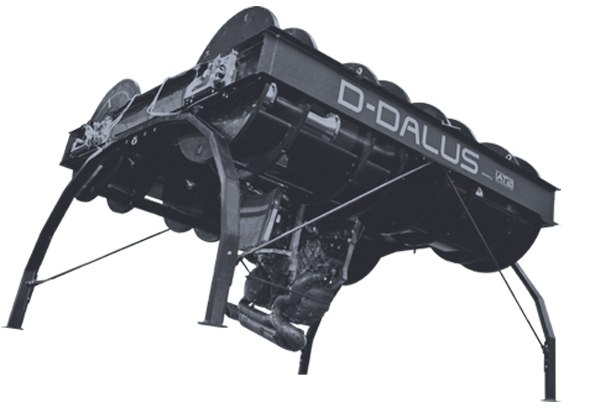Austrian firm IAT21 (the Austrian Innovative Aeronautical Technology Research Company) describes its free-floating UAS project D-Dalus as, “a totally new form of airborne auto-motion”. It hovers and flies without wings or rotors.
It uses four, mechanically-linked turbines to provide propulsion. They’re all running at 2,200 rpm and servos can push and reposition the blades to deliver that thrust in any direction. So the D-Dalus can launch and land vertically, hover perfectly still and zip about in any direction with 360 degrees of movement. A series of computer algorithms work overtime to keep the aircraft upright, while a pilot simply uses a traditional joystick.
IAT21 claims that its aircraft outclasses fixed and rotary wing UAS. Normal UAS don’t perform well during bad weather, while moving at any speed, when trying to be covert and when attempting to land on a moving target. D-Dalus takes its inspirations from elsewhere: namely balloons, birds and balls. It will apparently approach as gently and silently as a hot air balloon, hover like a hummingbird, rotate in mid air like a football and land on the deck of a ship like a “tossed pancake”.
D-DALUS is currently in the prototype stage. Over recent weeks IAT21 has conducted extensive constrained flight tests in a specially prepared laboratory near Salzburg, including the transition from vertical to forward flight, and are now ready to move to an open test range for free flight tests. In trials to date D-DALUS has met the performance criteria placed upon it and appears to be scalable, becoming more efficient and less complex as it increases in size. It will therefore be ideally suited for applications that range from maritime search and rescue, through the carriage of freight, to operating alongside and within buildings during fires or, for example, nuclear accidents
IAT21 has formed a collaborative partnership with Cranfield University in the UK to take the aircraft forward to full flight certification.
Prof Kevin Knowles, head of the university’s aeromechanical systems group, said the concept was similar to several other proposed cyclo-rotor vehicles, but the way the blades were positioned meant that it could change direction differently. ‘By having the axes of the rotors parallel to the direction of flight, the thrust from them can be directed left and right very easily, or up and down, but it can’t be directed forwards and backwards,’ he said. ‘To make it pitch, you have to change the thrust between the forward and rear pairs of rotors, which apparently they can do.’
He said that the main problem for any craft such as this was switching from vertical take-off to forward movement, but Wills said that the design overcame this issue because it could thrust in any direction. ‘It has no concern about flying at any angle so it goes from vertical to horizontal, just from a change of 90° in resultant thrust,’ said Wills. He added that D-Dalus would take at least five years to develop into a mature technology. ‘This is going to have tons of technological bugs that we haven’t yet predicted, just like the jet engine or hovercraft — which took years to get to maturity from the original idea,’ he said.
IAT21 has submitted proposals for the craft to the British, French and US ministries of defence and spoken to several major firms, including EADS and helicopter manufacturer AgustaWestland.
Source: Company Web-Site, The Engineer

